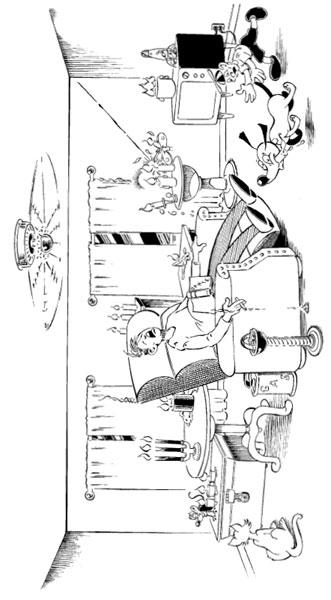When All Hell Breaks Loose (69 page)
Read When All Hell Breaks Loose Online
Authors: Cody Lundin
Candles should be placed at least three inches apart from one another. This is to be sure they don't melt one another or create their own drafts that will cause the candles to burn improperly.
One of the safest ways to extinguish a candle is to use a candlesnuffer, which helps prevent hot wax from spattering.
Do not extinguish candles with water. The water can cause the hot wax to spatter and can cause glass containers to break.
Flashlights and other battery-powered lights are much safer light sources than candles during a power failure.
Never use a candle as light when you go into a closet to look for things.
Never use a candle for light when fueling equipment such as a lantern or kerosene heater.

A fairly simple invention, a candle consists of a
wick
and
fuel
. The candlewick is responsible for moving the liquefied fuel upward via capillary action where it is vaporized within the candle's flame. Wicks can be composed of everything from dried moss or twisted cloth to finely braided glass fiber. Today, there are more than one hundred different wicks on the market from domestic and imported sources. For the most part, a high-quality wick is made from a braided fabric (the majority of which are 100 percent cotton or cotton-paper combinations), while a lower-quality wick is twisted, such as those used in birthday candles. The most common wicks are flat wicks, square wicks, cored wicks, and specialty and oil lamp wicks. Flat wicks are very consistent, flat-plaited wicks that curl in the flame for a self-trimming effect. Square wicks are braided wicks that also curl in the flame and are preferred in beeswax applications and can help inhibit clogging of the wick when high levels of noncombustible materials such as pigments and fragrance are used. Cored wicks are braided wicks with a round cross section and are designed to remain straight while burning. These wicks contain a separate core material of zinc, tin, cotton, paper, or dangerous lead, and are used in jars, columns, votives, and devotional lights. Specialty and oil lamp wicks are designed specifically for burning oil lamp fuels and insect-repellent flames.
The fuel element of a candle can consist of everything from mule deer fat and shortening to paraffin, beeswax, or, as colonial women figured out, boiling down the grayish green berries of bayberry bushes to produce a clean-burning, sweet-smelling wax.
An important note about lead wicks:
More than twenty-five years ago, members of the National Candle Association, which makes 90 percent of the candles in the United States, agreed to ban lead wicks from their products; but how to tell if you're buying one of the other 10 percent is hard to figure out. Imported candles, most notably those from China and the religious candles made in Mexico, have been found to contain lead wicks, so do some research on what you are buying. To test candles for possible lead-core wicks, take a piece of white paper and rub the tip of an unburned candlewick onto the paper. If it leaves a light grey, pencillike mark, it has a lead-core wick. User-safe zinc or tin-core wicks should not leave any mark on the paper.
Storing and Using Candles
I burned candles and oil lamps for years as the primary source of light in my home before my investment in solar photovoltaics. Candles require thought regarding their storage, especially in areas of extreme environmental heat. I have trashed many a candle in unrelenting Arizona temperatures. Store your candles in a cool, dark, dry place. Longer dinner or taper-type candles should be stored flat to prevent warping. Think about candle placement in your home for safety and greater efficiency. Candles placed on a windowsill can deform or melt in the sun. High areas in homes such as lofts and attics, while shaded from direct sun, can reduce a candle to a puddle from the simple fact that hot air rises.
A well-made candle should not soot or smoke when burning properly. Smoking will occur, however, whenever a candle's flame is disturbed, which allows unburned carbon particles (soot) to escape. Any candle can be made to smoke by causing the flame to flicker from a draft. Although the soot produced by quality candles does not present a health concern, it can be a drag in close quarters with minimal opportunities for ventilation. Minimize candle flickering by trimming the wick to one-fourth inch before lighting, as well as keeping the candle free from blower vents, obnoxious drafts, and strong air currents.
Tips for Getting the Old Wax out of Your Candleholders
Poorly fitting candles caused by old wax stuck within candleholders can be dangerous as they are more prone to being knocked from their holder. To make cleaning your candleholders easier:
run very hot water over them or leave them (metal holders) outside in hot summer sun
OR
place the holder in a freezing environment, allowing the wax to shrink and pop off
OR
for votive candles, think ahead and add a few drops of water to the glass before inserting the candle. A word of caution: Do not add more than a few drops and don't add water unless you intend to burn the candle immediately afterward. If not burned immediately, the candle's wick can, over time, absorb the water and no longer burn properly. Don't use a sharp object to remove old wax from glass holders as it could weaken the glass, causing it to break upon subsequent use.